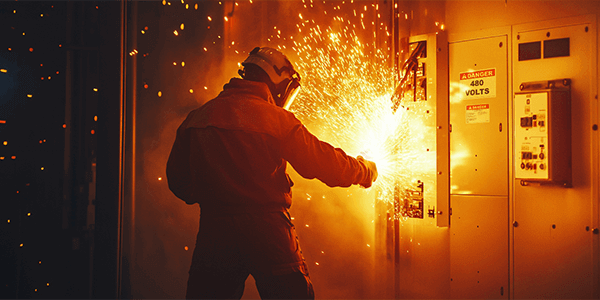Understanding Electrical Ground Fault Protection in the Workplace

Why Should Workplaces Be Concerned About an Electrical Ground Fault?
It is important to consider the hidden dangers that might be lurking within workplace electrical systems. An electrical ground fault, which is often overlooked, can have serious consequences if left unchecked. For example, the U.S. Bureau of Labor Statistics (BLS) reported that 145 fatalities occurred from exposure to electricity in 2022. Understanding the potential dangers of ground faults is an essential part of building a safe environment while maintaining the reliability of your electrical systems. Knowing when do ground faults happen is a critical part of that awareness.
What is an Electrical Ground Fault?
A electrical ground fault occurs when an unintended path between an electrical power source and a grounded surface is established. When a live wire comes into contact with a grounded part of a system or the ground itself, it disrupts the electrical system’s normal flow, potentially leading to hazardous situations.
These faults can lead to serious injuries, electrical fires, and equipment damage. Not only do they pose a safety risk, but they can also disrupt operations and cause downtime. Understanding when do ground faults happen helps workers anticipate these risks and take corrective action.
For example, a worker in California used a 120 V electric drill to repair a door on a loading dock. The drill had a three-prong plug, but the grounding prong was missing. A electrical ground fault occurred, energizing the drill casing and sending current through the worker’s body. He died of electrocution.
Addressing ground faults promptly and effectively keeps employees safe and electrical systems in working order. Being able to recognize indicators and having protocols in place to prevent ground faults are essential components of workplace risk management.
Common Causes of an Electrical Ground Fault in Industrial Settings
When do ground faults happen? In industrial settings, they can arise from numerous sources. One of the most common causes is insulation breakdown, where protective insulation wears down and enables electricity to leak to the ground or nearby conductive surfaces.
Other causes of an electrical ground fault include: 
- Improper wiring
- Equipment failure
- Surge in voltage
These incidents have far-reaching consequences, impacting employee safety and overall facility operations. Disruption caused by ground faults leads to accidents, downtime, and costly repairs. Organizations must identify and prevent ground faults through comprehensive safety programs. Facilities that ignore these hazards will face regulatory violations and fines.
Regulatory Requirements for Electrical Ground Fault Safety
Regulatory bodies such as OSHA enforce strict guidelines to protect workers from electrical hazards, including electrical ground fault protection. OSHA standards, such as 29 CFR 1910 Subpart S, outline the necessary safety measures for managing electrical risks, such as installing and maintaining grounding systems.
Compliance is critical to avoid penalties and maintain a safe workplace. Failure to adhere to these standards can result in significant fines and increased liability. Regularly reviewing and updating safety protocols—and understanding when do ground faults happen—reduces risks and helps maintain compliance.
Even when a facility is compliant, knowing how to prevent ground faults provides additional safety margins.
How to Prevent Ground Faults in the Workplace
Organizations can take proactive steps to prevent ground faults instead of waiting for problems to occur. This approach is crucial for maintaining a safe workplace environment.
- Perform Regular Inspections
Regular inspections help detect signs of wear, damage, or potential faults in wiring and equipment. This makes it easier to identify when do ground faults happen and address issues early. - Ensure Consistent Maintenance
Consistent maintenance of electrical systems is essential to prevent ground faults and other electrical hazards. Regular maintenance tasks, such as cleaning, testing, and repairing equipment, help ensure that all components function correctly. This ongoing care reduces the risk of malfunctions and enhances the overall safety of the electrical infrastructure. - Wear Appropriate Personal Protective Equipment (PPE)
Proper PPE, including insulated gloves, safety glasses, and a hard hat, provides needed protection when working with or around electrical systems. It prevents workers from becoming a pathway for hazards of electricity to flow through. - Use Ground Fault Circuit Interrupters (GFCIs)

Advanced protective devices like GFCIs can significantly lower the risk of electrical accidents by quickly detecting and interrupting ground faults. These devices provide an added layer of protection against electrical hazards to ensure the safety of employees by aligning with OSHA electrical safety best practices. - Apply Clear Signage and Labeling
Clear and informative signs and labels play a critical role in enhancing safety protocols by providing reminders when employees are at risk. By strategically labeling electrical panels, equipment, and high-risk areas, employees are better equipped to identify potential hazards and take necessary precautions. Warning signs placed near hazardous zones serve as visual reminders of potential dangers, while instructions for safe equipment usage promote safety and awareness in the workplace. DuraLabel’s customizable signs and labels offer a practical and durable solution that can accomplish all of these safety needs. - Conduct Educational Programs
Educational programs are another essential component of a comprehensive safety strategy. Organizations empower their workforce to take proactive measures in preventing accidents by providing employees with training on how to recognize and respond to electrical hazards. These programs not only increase awareness of potential risks but also instill a sense of responsibility towards maintaining a safe working environment for all.
By incorporating these preventive measures into workplace safety practices, businesses can effectively mitigate the risks associated with ground faults and uphold OSHA electrical safety standards. Through a combination of advanced protective devices, clear labeling, and employee training programs, organizations can prioritize electrical hazard awareness and prevention.
DuraLabel Signage Solutions for Electrical Ground Fault Safety
DuraLabel's range of industrial signs and labels offers a practical solution to enhance electrical safety and compliance in the workplace. The durable materials ensure that warning and instructional labels remain legible in harsh industrial environments.
Create and print your own electric safety signage with the DuraLabel Kodiak Max Industrial Sign and Label System. These signs and labels can be used to mark electrical panels, equipment, and specific zones where ground fault protection is a concern. Specific labels can highlight the presence of GFCIs or indicate the location of inspection points for increased awareness of potential ground faults.
By tailoring your signage to address ground fault issues directly, DuraLabel helps ensure that all employees are well-informed about the risks and necessary precautions to take when working with or around electrical systems.
Are you looking to learn more about OSHA electrical safety? Download DuraLabel's free, in-depth Electrical Safety Quick Start Guide to ensure regulatory compliance, reduce electrical incidents, and more!
Read Next:
Related Resources

What Every Engineer Should Know About Preventing Arc Flash Incidents
How Can Labeling Help Prevent and Arc Flash Incident? An arc flash incident occurs when electrical current ...
Read
Arc Flash Labeling Essentials for Industrial Facilities & Field Teams
What Makes Arc Flash Labeling Essential for Electrical Safety? A loud explosion. A sudden flash of blinding ...
Read
The Overlooked Fix That Improves Electrical Panel Safety
How Do Electrical Panel Labels Improve Safety and Compliance? Electrical panels are essential to every ...
Read.png)




%20(1).webp)
